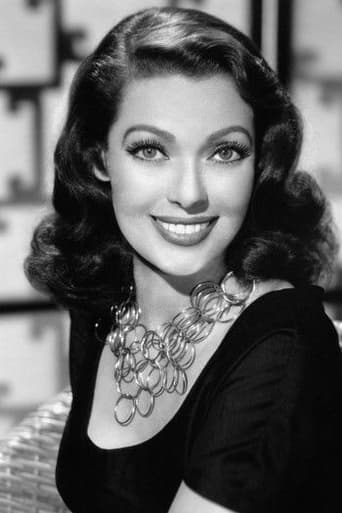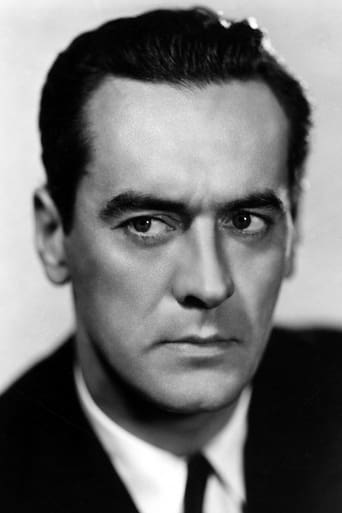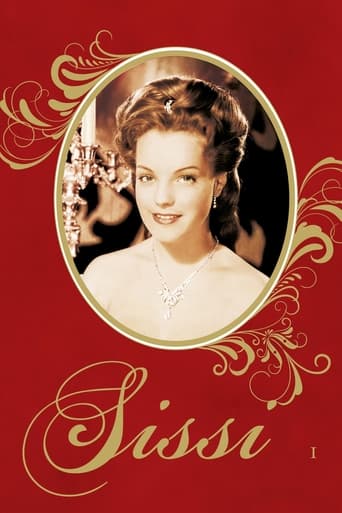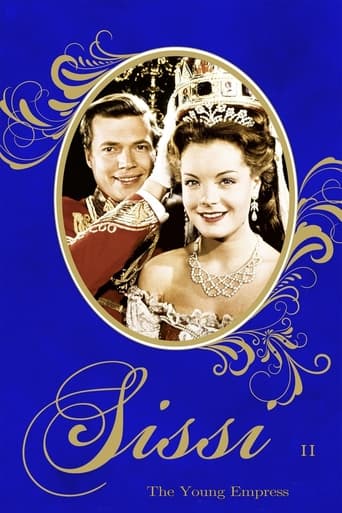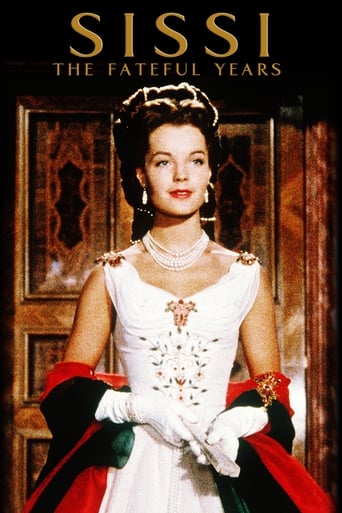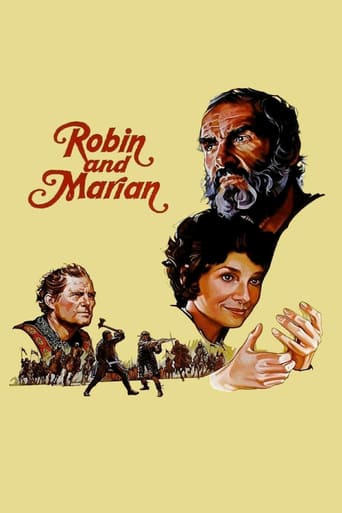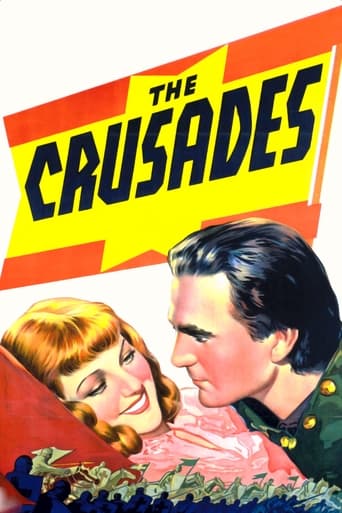
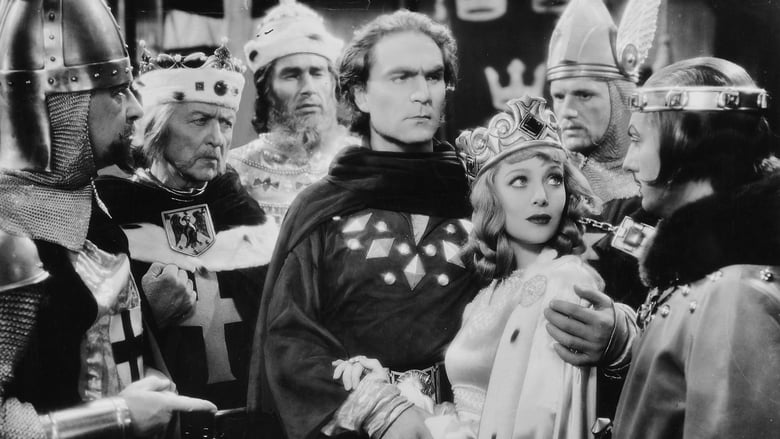
The Crusades (1935)
King Richard the Lionhearted launches a crusade to preserve Christianity in Jerusalem.
Watch Trailer
Cast
Similar titles
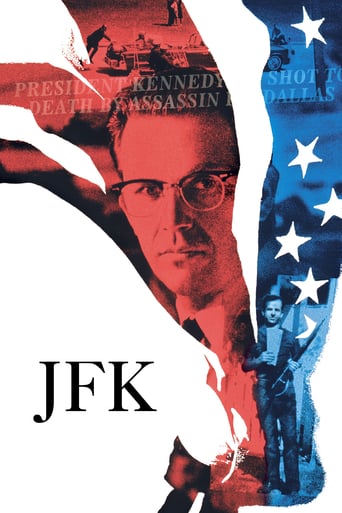

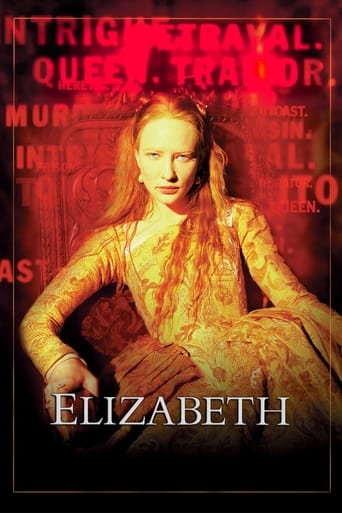
Reviews
So much average
Powerful
From my favorite movies..
Each character in this movie — down to the smallest one — is an individual rather than a type, prone to spontaneous changes of mood and sometimes amusing outbursts of pettiness or ill humor.
While "The Crusades" features a very impressive cast, the film itself is tedious as well as often historically inaccurate. It's not terrible...but you could do a lot better.In movies from the 1930s-50s, Richard the Lionhearted (Richard I of England) is a very noble warrior (such as in "Robin Hood" and "Ivan hoe") but in real life he was a blood-thirsty maniac--a man who had no interest in ruling England (having spent very little time there during his lifetime). He was NOT very noble or chivalrous and was probably one of England's worst kings. Instead, he delighted in going to war and was renowned for his bravery and brutality--sacking cities and killing everyone inside! He spoke French--or at least the French language of his empire in what is modern Western France. Although he adored war and manly deeds, he showed little interest in women--and pretty much ignored his wife. This has led to speculation that he was gay. Not surprisingly, he didn't leave an heir.Now the Cecil B. DeMille version of Richard (Henry Wilcoxon) in "The Crusades" is not as flowery and ridiculous as that in many other films of the era. He was a warrior first in this film--which is who Richard truly was. But, in the film he is a nice and good king--a man to be admired (ha!). And, although initially showing no interest in women or his poor wife, the film later shows a touching romance between him and his queen, Berengaria (Loretta Young). Weirdly, however, his strange relationship with his enemy, Saladin (Ian Keith) isn't that far from reality. Despite being enemies, there was a strange respect and admiration between them--and when ill, Saladin really did apparently send doctors to treat Richard! Let's put aside the historical problems with the film (there are many more). After all, as a retired history teacher, it's easy for me to go on and on about this...and thus bore you to tears! How is the film as entertainment? Well, it's a very mixed bag. Despite being a film about war and death and the like, it's amazingly subdued and VERY talky through the first half of the film. I kept hoping to see someone kill someone--but they kept talking and talking. Some of this wasn't all bad (there was a serious rivalry between Richard and the King of France--and a lot of plotting) but for an action film, there was a tremendous lack of action. Later, things did heat up a bit and I must admit the costumes and battles were pretty well orchestrated--though on a relatively small scale (despite nice props, for a DeMille film is lacked the huge cast you'd usually expect). And, even when fighting FINALLY broke out, there still was a lot of talking and talking. It's not good...but at least it beats "King Richard and the Crusaders"--a horrible epic about the same material done in the 1950s.So, overall, it's a dull film with some historical errors. It's certainly not among the worst films about the subject but you can certainly do better. For example, the wonderful series on the Crusades by Terry Gilliam is leap-years better--more interesting, more accurate and, oddly, a bit funny.
This loosely told story of the Crusades isn't so bad historically, if one allows for this one "crusade" to represent a total summation of all the Crusades, probably de Mille's goal.But while de Mille gives a fairly accurate portrayal of some historical characters (if one reads between the lines), he gives a totally bizarre portrayal of their personal lives that could not possibly be believed.First, the few things that make sense. Richard was not a "Christian", and de Mille shows this. He gave the usual lip service, but he represented the "mercantile" endeavors of those who used the papal promises for their own ends. The pope made the mistake of granting Richard rule over all Christians in the conquered lands. What this led to was Richard simply slaughtering any person who wasn't guaranteed to be under his rule, which meant non Christians.This was the savagery of the Crusades. It had nothing to do with religion, but of men taking advantage of religion. In a subtle way, de Mille does show this.Saladin was well depicted. Despite what critics say, he was one of the more benevolent of warriors, which isn't saying a lot, but if you were captured by a Moslem force, you would rather it be by Saladin than most others. He could be reasoned with. if nothing else, you could convert to Islam and be spared by him.The business with the sneaky European who Saladin killed is derived from another instance, well chronicled, dealing with a man whose evil was not nearly as "Mickey Mouse" as this villain, and who would've tried any person's patience. he was the terrorist of the era, and Saladin offered the cup of safety to everyone he captured but this man. The incident is depicted fairly faithfully in the modern epic "Kingdom of Heaven".de Mille simply combines all the events into one main event, and that's fair poetic license. Certainly closer to the truth than "Tombstone" is of Wyatt Earp and the Clantons.The personal lives are laughably unbelievable. King Richard comes across as gay (and he probably was gay or bisexual), resisting romance with the gorgeous princess of France, spurning her, and then later becoming enchanted with a very homely princess of another land. Loretta Young looks her worst for this. She is figuratively the ugly step sister, and we see the hand of women in the making of this to be a chick flick, where the homely girl gets the romance and the pretty girl is out in the cold. Nice fantasy for the female wallflowers, but men had to be shaking their heads at this, particularly when Saladin falls for the pale homely girl, when we know how beautiful Arabian women are. Loretta is not usually this plain. Her hair looks pitifully bland, but we have to remember this is a Hollywood movie, and Hollywood has always pushed the "blonde woman" look in heir chick flicks to appease the female audience.We get a lot of ho hum, no risk, same old stuff. The nice guys all die, of course, true to Hollywood clichés. The hero has to start off as a creep, and actually he's a total monster, but de Mille does some clever snake oil soft soap to make us think he isn't a monster.It's easily one of de Mille's worst works. But we see some of the skills that made de Mille great later. de Mille knew how to make a logical sequence of events, how to cut and edit, the importance and timing of comic relief. he was still in the experimental stage on his total skills, but we see a hint of them here.
Having witnessed the flop of his last few contemporary dramatic pictures, Cecil B. DeMille made a pledge to the public that from now on he would only make epics. True to his word, he strove to make each successive picture more stupendous than the last. He had made some very effective shoestring epics in the poverty-stricken early 30s, but by 1935 the worst of the depression was over and DeMille could at last be reunited with the big budget.While DeMille had proved on Sign of the Cross (1932) and Cleopatra (1934) that he could make a big picture without masses of extras or impressive sets, he certainly knows how to make the most of those assets when he does have them. It is in The Crusades that we see the development of the style of presentation that he employed for all his subsequent epics. Rather than bombard us with the colossal, he likes to gradually reveal the vastness of a place by slowly and smoothly pulling the camera back. During these moves he usually has an extra or two move horizontally across the frame at a similar pace to the camera, giving the manoeuvre extra grace and momentum. Then there are the battle scenes, tense and frenzied creations of Anne Bauchen's superb editing. These are similar to the ones in Cleopatra, but far more effective, not because of the higher production values, but because the shots are held for longer and their sequencing is better timed.And while DeMille clearly loves the massive crowd shot, he has enough sense to shrink the space and simplify the setting when it comes to key dialogue scenes. Compared to the busy outdoor locations many of the interiors are quite plain, which helps to focus us entirely on the actors, their expressions and their words. The transitions to these dramatic moments are often very smooth, with the drop of a tent flap or simply a change of angle to frame the actors against a bare wall. DeMille was an expert in turning the spectacle on and off, as it were, according to the demands of the narrative.Given the above, it's a pity that, like most DeMille pictures of this era, The Crusades is dramatically rather weak. The dialogue is bland, and most of the characters are lazily-written stereotypes. In the early scenes, there seems to have been this attempt to cram in as many "Olde Englande" accessories as possible, with a cheeky minstrel, a burly blacksmith, the king and his court all hanging out together. Mind you, there is at least a fairly decent character arc in that King Richard is portrayed as a kind of medieval cad who joins the crusade for ulterior motives, but is eventually humbled by his experiences. It's also a refreshingly mature approach to make Saladin an honourable foe, although there is of course still the obligatory moustachioed villain in the form of some anachronistic minor king (played by Joseph Schildkraut, naturally).After having suffered Henry Wilcoxon's wooden turn as Mark Anthony in Cleopatra, it's a major disappointment to see him again in a leading role. You might wonder why DeMille so persistently cast amateurs like Wilcoxon, until you realise he selected players primarily for their physicality, their talent being of secondary concern. In this light it makes sense for Wilcoxon, with his prominent brow and broad shoulders, to play a king. And although Joseph Schildkraut was, as it happens, a very good actor, DeMille repeatedly cast him as these Judas figures because of his thin face and piercing eyes.But this is DeMille. Script and cast will always play second fiddle to the director's showmanship. Despite all the baloney and anachronism, his visual style is on top form here. The Crusades is like a stained-glass window in a church. It will not reach us on an emotional, human level, but it is full of grace and majesty. Yes, DeMille is often called a Victorian moralist, but in his presentation and imagery he was practically medieval. And we should forgive him, because he did it so well.
"The crusades" (1935) directed by Cecil B.De Mille is as story conceived as love affair, explaining part of the influence that it produced in the internal affairs of two countries as nations in Europe, promoting the allegedly third crusades against Islam, situated at the corner of Southeast on Mediterranean sea. Overall, at the time of vessels charged with horsemen, some of them who went fighting for an apparently common faith but forgotten the symbolic land and cultural influence of diversified local populations, far away of their respectively reigns like France and England. The spirit of cavalry, wedding intrigue, eroticism on the drapes and campaign bed of kingdom of Christianity are ingredients of adventure at the land lost, meaning expansionism and its pretext for quarreling about frontiers and warriors in a love affair at the mood. Director Cecil B.De Mille enjoying us with such subject, altogether he capsizes over our child mind, maybe he was thinking in another configuration for the problem of imperialism and the propriety of rights from these times linking two things, fanaticism and medieval glory at the time of Abyssinia and its nature of rivalries where sex attraction concealed by the strength for power. A tent is the main location concerning an attitude for dealing and in this place both sides made what is better for each one of the intervenor before peoples in conflict in a postponed peace deal. The scene is that tent where both sides entering and a woman is the subject of sharing in between affects that are responsible for the way that the present crusade is understood by the chiefs in place with their costumes and clothes that the director put his energy not to explain why but what burns the heart of kings in that phase of humanity and superiority of Europe before its extremities... This kind of acting at the time was watched as explaining the orders of knighthood in a displaying manner of obvious meaning on public stage at the corner of a town of the ancient world. But historically displaced from the real present time of then in 1935 not at all in relationship of others in incendiary domestic mission where it was inserted such a Hollywood production as a flop.
